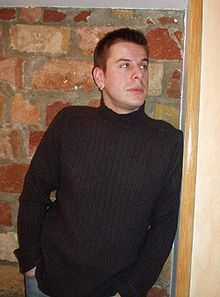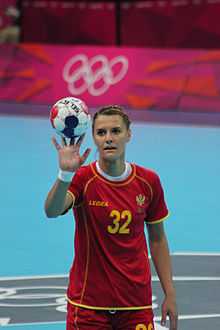Serbs of Montenegro
| ||||||||||||||||||||||||||
| Total population | ||||||||||||||||||||||||||
|---|---|---|---|---|---|---|---|---|---|---|---|---|---|---|---|---|---|---|---|---|---|---|---|---|---|---|
| 178,110 (2011)[1] | ||||||||||||||||||||||||||
| Languages | ||||||||||||||||||||||||||
| Serbian | ||||||||||||||||||||||||||
| Religion | ||||||||||||||||||||||||||
| Serbian Orthodox Church | ||||||||||||||||||||||||||
| Related ethnic groups | ||||||||||||||||||||||||||
| Montenegrins | ||||||||||||||||||||||||||
| Part of a series of articles on |
| Serbs |
|---|
 |
|
Native communities
|
|
Europe
Overseas
|
|
|
|
Related people |
Montenegrin Serbs (Serbian: Crnogorski Srbi/Црногорcки Cрби) or Serbs of Montenegro[a], compose the second largest ethnic group in Montenegro (28.7% of country's population[2]), after the Montenegrins. In historiography, the Orthodox people of Montenegro were called Serbs. In the constitutions of the Principality of Montenegro and Kingdom of Montenegro, the Montenegrin people's ethnonym was Serbs. With the formation of Socialist Yugoslavia, the censuses showed a majority of people declaring as Montenegrins.
History
Middle Ages
Slav raids on Eastern Roman territory are mentioned in 518, and by the 580s they had conquered large areas referred to as Sclavinia.[3] According to Byzantine sources, Serbs lived in a region in the Western Balkans in areas which were organized into župa, an administrative division held by a župan. Early polities include Paganija, Zachumlje, Travunija with Konavle, Duklja, and Serbia with Bosnia. Višeslav (fl. 768-814), the first known Serbian monarch by name, ruled the counties of Neretva, Tara, Piva, and Lim;[4] he managed to unite several more tribes into what would become the Serbian Principality. According to the Royal Frankish Annals, in 822, Serbs inhabited the greater part of Dalmatia (Sorabos, quae natio magnam Dalmatiae partem obtinere dicitur).[5][6][7] Prince Vlastimir united Serbia in wake of the growing threat of the Bulgars,[8] and his realm spanned over southwestern Serbia, much of Montenegro, eastern Herzegovina and southeastern Bosnia.[9] Prince Petar Gojniković defeated Tišemir of Bosnia, annexing the valley of Bosna.[10] He then expanded along the Neretva, annexing the Narentines, where he seems to have come into conflict with Michael Višević, a Bulgarian ally and at the time ruler of Zahumlje (with Trebinje and most of what would later be Duklja).[11] Višević heard of the possible alliance between Serbia and the Byzantines, and warned Symeon.[11] Symeon defeated Petar[12] and in the following years there was a power struggle between the Bulgars and Byzantines over Serbian overlordship.[13] Prince Časlav Klonimirović ruled over a confederacy of statelets covering an expansive area, uniting the tribes of Bosnia, Herzegovina, Old Serbia and Montenegro (incorporated Pagania, Zahumlje, Travunia, Konavle, Bosnia and "Rascia" into Serbia, ι Σερβλια).[14][15] He took over regions previously held by Michael, who disappeared from sources in 925.[15] According to some sources, Časlav's 'state' was based from the hinterland of Kotor.[16]
With a Byzantine annexation of Serbian territories, the county of Duklja becomes the seat of the Serbian state. The Serbian diplomatic mission whose arrival in Constantinople in 992 was recorded in a charter of the Great Lavra Monastery written in 993, was most likely sent from Duklja.[17] Jovan Vladimir had his court centered in Bar on the Adriatic coast, and had much of the Serbian Pomorje ('maritime') under his control, including Travunia and Zachlumia. His realm may have stretched west- and northwards to include some parts of the Zagorje ('hinterlands', inland Serbia and Bosnia) as well. Cedrenus calls his realm "Trymalia or Serbia",[18] according to Radojicic and Ostrogorski, the Byzantines calls Zeta - Serbia, and its inhabitants Serbs.[19]
Around 1034, the Serbs retaliated against the Byzantines under the leadership of Stefan Vojislav, a "Travunian Serb" and archon of "Dalmatia, Zeta, and Ston", possibly kin to Jovan Vladimir. He organized a revolt during a Byzantine succession, and was captured in 1036, though escaped jail in Constantinople in 1038 and returned to his lands, where he instigated another revolt and managed to defeat strategos Theophilos Erotikos (1039), strategos Michaelus Anastasii (1042), and Byzantine ally Ljutovid of Zahumlje (1043), and ruled independent until his death in 1043.
Principality of Montenegro / Kingdom of Montenegro (1852–1918)
According to "paragraph 92" in the code of Prince Danilo (1855), the Montenegrin people were ethnic Serbs and Eastern Orthodox by faith, and also "part of the Serb nation".[20]
Kingdom of Yugoslavia (1918–1941)
Montenegro saw independence under the House of Petrović-Njegoš, firstly as a principality and then as a kingdom. Both Kingdoms fought together as independent states in the Balkan Wars and in the First World War. At the end of the war in 1918 tensions arose between the two states as the Montenegrin Whites with Serbian support deposed Nicholas I of Montenegro and proclaimed Montenegro's unification with Serbia as part of Kingdom of Serbs, Croats and Slovenes (renamed into Kingdom of Yugoslavia in 1929), while the Montenegrin Greens opposed it. The conflict led to the Christmas Uprising, in which the Whites with support from the Serbian army defeated the Greens.[21] During the period of the monarchic Yugoslavia, ruled by the Serbian dynasty of the House of Karađorđević, the tensions between Serbs and Croats were increasing and most of the Montenegrin politicians supported the Serbian proposed centralised state.
World War Two and Socialist Yugoslavia (1941–1992)
During the Second World War both Serbs and Montenegrins were very active in both resistance movements, the Yugoslav Partisans and the Yugoslav Army in the Fatherland known as the Chetniks. At the end of the war the socialist Yugoslavia was created and the two became republics within the Yugoslav federation.
Yugoslav Partisan Milovan Djilas described himself as a Montenegrin Serb and described Montenegro as the spiritual homeland of Serbs, saying "I am not a Montenegrin because I am a Serb, but a Serb because I am a Montenegrin. We Montenegrins are the salt of the Serbs. All the strength of the Serbs is not here [in Montenegro] but their soul is."[22] Djilas also has said "The Montenegrins are, despite provincial and historical differences, quintessentially Serbs, and Montenegro the cradle of Serbian myths and of aspirations for the unification of Serbs.".[22]
Serbia and Montenegro (1992–2006)
After the secession of Slovenia, Croatia, Bosnia and Herzegovina and Macedonia in 1991 and 1992, SR Montenegro held the Montenegrin referendum in 1992 which ended with a 95.96% of votes in favour for a state union with Serbia and with the changing of the socialist political system towards a multi-party one. The country was renamed Federal Republic of Yugoslavia. In this period between 1990 and 1998 Montenegro was ruled by Momir Bulatović who had close relations with the Serbian president Slobodan Milošević and who was very supportive to keep close ties between the two republics within the state union. Montenegro was also included by the economic sanctions imposed to Serbia during the 1990s. During the 1999 NATO bombing of Yugoslavia both Serbia and Montenegro suffered the attacks of the NATO forces and several targets inside Montenegro were also bombarded. All this contributed to the rise in power in Montenegro of Milo Đukanović who was known to be much less sympathetic towards the Serbo-Montenegrin ties and would became an open supporter of the independence of Montenegro. In 2006, six years after the fall of Milošević in 2000, and after insisting on international diplomacy, the former Yugoslavia became known as the state union of Serbia and Montenegro. The process of becoming a single state union ironically lead to the separation of the two states - a change which was officiated by the referendum on Montenegrin independence on 21 May 2006. A total of 419,240 votes were cast, representing 86.5% of the total electorate. Of them, 230,661 votes or 55.5% were in favour of independence and 185,002 votes or 44.5% were against.[23]
Independent Montenegro (2006–present)
Since independence, the Montenegrin society has been divided among many issues. The independence supporters are advocating for the creation of a separate Montenegrin language, regarded before as a dialect of the Serbian language, including the creation of a new Montenegrin Cyrillic alphabet which is basically the Serbian Cyrillic alphabet with the addition of two new letters. The Serbian population of Montenegro is opposed to the idea of a linguistic separation, just as they are opposed to the separation of the Montenegrin Orthodox Church from the jurisdiction of the Serbian Orthodox Church. The Montenegrin language lacks ISO code, and the Montenegrin Orthodox church is canonically unrecognized.
The links between the two nations remains strong, and the fact that for the last two centuries a great number of Montenegrins had emigrated to Serbia further strengthens the ties. The Montenegrin littoral is still the main turistic destination for citizens of Serbia, and a large population of Serbians own property in Montenegro. Many of these properties consist of summer homes, and contribute to a seasonal influx of Serbs in Montenegro, during the summers. Despite the geopolitical separation, the economic balance and relationship shared between the two countries continues to be strong.
Demographics
According to the 2011 census, Serbs are second largest ethnic group and constitute 28.7% of population of Montenegro. They are absolute majority in three and relative majority in another three municipalities, and constitute less than 20% of population in only four out of total 21 municipalities in the country. Percentage of Serbs in municipalities of Montenegro is as follows:
- Plužine (65.6%)
- Andrijevica (61.8%)
- Pljevlja (57%)
- Herceg Novi (48.9%) (relative majority)
- Berane (42.9%) (relative majority)
- Šavnik (42.4%)
- Žabljak (41.3%)
- Budva (37.7%)
- Bijelo Polje (35.9%) (relative majority)
- Kolašin (35.7%)
- Mojkovac (35.4%)
- Tivat (31.6%)
- Kotor (30.5%)
- Danilovgrad (27%)
- Bar (25.3%)
- Nikšić (25.3%)
- Podgorica (23.2%)
- Plav (16%)
- Ulcinj (5.7%)
- Cetinje (4.3%)
- Rožaje (3.6%)
Culture
Language
The national language of Montenegro has historically and traditionally been called Serbian.[24] According to Pavle Ivić, two sub-dialects of the Shtokavian dialect (of the Serbian language) were spoken in Montenegro: the Eastern Herzegovinian dialect and Zeta-South Sanjak dialect. The Eastern Herzegovinian dialect is spoken in Montenegro, Serbia, Bosnia and Herzegovina and Croatia. Today, the national standard is based on the Zeta-South Sanjak dialect.
Some 42.9% of the population of the country speak Serbian as their mother tongue, including 37% of the declared Montenegrins. Serbian was the official language of Montenegro until 2007 when the new Constitution of Montenegro replaced the Constitution of 1992. Amid opposition from pro-Serbian parties,[25] Montenegrin language was made the sole official language of the country and Serbian was given the status of a recognised minority language along with Bosnian, Albanian, and Croatian.[26]
Religion

The Serbs are adherents of the Serbian Orthodox Church, the strongest religious institution of Montenegro (with a total of 460,383 followers or 74%).[27] One of the largest places of worship is the Cathedral of the Resurrection of Christ in Podgorica.
The future of the Serbian Orthodox Church in Montenegro has been threatened by the newly formed Montenegrin Orthodox Church which has claimed Serbian Orthodox churches in Montenegro, and is backed by a small percentage of the Orthodox Christians in Montenegro. The government has recognized the church, however none of the Eastern Orthodox churches have. The leader is the controversial Miraš Dedeić, a former Serbian Orthodox clergyman with Serbian nationalist views that after being suspended from the Serbian Church, went to Rome and became a Greek Orthodox clergyman. He was later suspended by the Serbian Orthodox Church after committing adultery with a younger woman. In 1997 he was excommunicated by the Holy Synod of the Ecumenical Orthodox Patriarchate of Constantinople from the Eastern Orthodox Church. Montengrin Orthodox Church's leader is anathemized by the Ecumenical Patriarchate of Constantinople and banished from Orthodoxy.
Folk attire
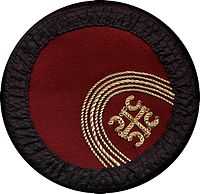
The Montenegrin cap is a traditional hat for ethnic Serbs in Montenegro and in later times the self identifying Montenegrins, originally in the shape of a flat cylinder, having a red upper surface (called tepeluk) not dissimilar to the Herzegovina and Lika caps. It was wholly red until Prince-Bishop Petar II Petrović Njegoš surrounded it with a black rim (called derevija),[28] and the definition given was as a sign of grief of occupied Kosovo. The Kosovo Myth was very popular in the Prince-Bishopric of Montenegro. The enforcement of the cap upon the Montenegrin chieftains by Peter II was a mark of expression of then's dominating Serbian national identity.[29] The national telling recorded the most often version of the cap as following: the black wrapper was sign of grief for the once big Empire, the red the bloody defeat at the Battle of Kosovo[30] and the five small stripes on the top represent the remaining remains of the once greater Serbian realm,[31] which became increasingly popular amongst the common folk during the reign of Prince Danilo I Petrović-Njegoš. Within the stripes is angled a six star, representing the last free part, Montenegro, shining upon the fallen and conquered.[32] Worn by the rulers and chieftains, the version with the Four Ocil symbol in the star's place had become across the years with growth of nationalism excessively popular amongst the ordinary people, the symbol of the Serbian Orthodox Church, which effectively worked on maintaining and raising the national identity.
Notable people
- Janko Vukotić, military commander
- Patriarch Gavrilo V of Serbia
- Pavle Đurišić, military commander
- Borislav Pekić, writer
- Petar Lubarda, painter
- Milovan Đilas, politician
- Matija Bećković, poet
- Amfilohije Radović, archbishop
- Branko Kostić, politician
See also
| Wikimedia Commons has media related to Serbs of Montenegro. |
- Serbian-Montenegrin unionism
- New Serb Democracy
Notes
- ^ The correct political terms are Serbian: Црногорcки Cрби – Crnogorski Srbi, meaning "Montenegrin Serbs", and Cрби Црногорци - Srbi Crnogorci, meaning "Serbs Montenegrins". Specifically, Their regional autonym is simply Crnogorci (Црногорци) – , literal meaning Montenegrins,[33][34] the same as the ethnic group of Montenegrins). In the early modern times, before the Kingdom of Montenegro, people [living within present-day borders] were divided by the identities of Brđani (Brda), Hercegovci (Old Herzegovina), Bokelji (Boka Kotorska) and Crnogorci (Old Montenegro). Срби у Црној Гори - Srbi u Crnoj Gori, meaning "Serbs in Montenegro".
References
- ↑ http://monstat.org/userfiles/file/popis2011/saopstenje/saopstenje(1).pdf
- ↑ Official results of the 2011 Montenegrin census
- ↑ "Slavyane v rannem srednevekovie" Valentin V. Sedov, Archaeological institute of Russian Academy of Sciences, Moscow, 1995, p. (Russian)
- ↑ Count Cedomilj Mijatovic, Servia and the Servians, p. 3; John Anthony Cuddon, The companion guide to Jugoslavia, p. 454
- ↑ Serbian studies, Volumes 2-3, p. 29
- ↑ Eginhartus de vita et gestis Caroli Magni, p. 192: footnote J10
- ↑ The Serbs, p. 14
- ↑ Hupchik, p.
- ↑ The early Medieval Balkans. John V A Fine
- ↑ The early medieval Balkans, p. 148
- ↑ 11.0 11.1 Fine, 1991, p. 149
- ↑ Fine, 1991, p. 150
- ↑ Fine, 1991, p. 141
- ↑ The early medieval Balkans, p. 160
- ↑ 15.0 15.1 The entry of the Slavs into Christendom, p. 209
- ↑ Encyclopædia Britannica
- ↑ Ostrogorsky 1956, pp.273–5.
- ↑ Cedrenus II, col. 195.
- ↑ Nikola Banasevic, Letopis popa Dukqanina i narodna predawa, p. 79, Document
- ↑ Montenegrin Chieftains - Serbian Patriots
- ↑ Banač, Ivo (March 1988). The national question in Yugoslavia: origins, history, politics. Cornell University Press. p. 285. ISBN 978-0-8014-9493-2. Retrieved 11 December 2011.
- ↑ 22.0 22.1 Elizabeth Roberts. Realm of the Black Mountain: A History of Montenegro. London, England, UK: Cornell University Press, 2007. Pp. 1.
- ↑ "Montenegro vote result confirmed". BBC News. 23 May 2006. Retrieved 5 November 2011.
- ↑ cf. Roland Sussex, Paul Cubberly, The Slavic Languages, Cambridge University Press, Cambridge 2006; esp. v. pp. 73: "Serbia had used Serbian as an official language since 1814, and Montenegro even earlier.".
- ↑ "''Pro-Serbian parties oppose Montenegro constitution''". Setimes.com. 26 October 2007. Retrieved 5 November 2011.
- ↑ "Ustav Crne Gore". Snp.co.me. Retrieved 5 November 2011.
- ↑ see: Religion in Montenegro
- ↑ "Crna Gora i Crnogorci" by Vuk Stefanović Karadžić
- ↑ "O najstarijoj kapi kod Jugoslovena..." by Miodrag Vlahović
- ↑ Crna Gora... Narodni život i običaji" by Andrija Jovićević
- ↑ "Crnogorska muška kapa" by Zorica Radulović
- ↑ "Fizicki lik i izgled Njegosa" by Jovan Vukmanović
- ↑ Charles Seignobos, Political History of Europe, since 1814, ed. S. M. Macvane, H. Holt and Company, New York, 1900, pp. 663–664; excerpt from chapter XXI The Christian Nations of The Balkans, subchapter Servia and Montenegro, passages Montenegro
- ↑ "Projekat Rastko Cetinje – Slavenko Terzic – Ideoloski korijeni crnogorske nacije i crnogorskog separatizma". Rastko.rs. Retrieved 5 November 2011.
| Wikimedia Commons has media related to Serbs of Montenegro. |
| ||||||||||
| ||||||||||||||||||||||||
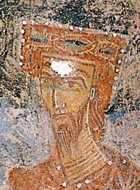
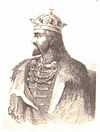
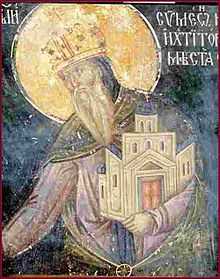


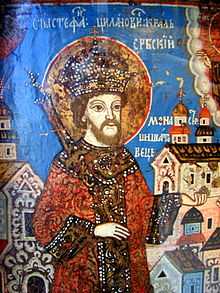

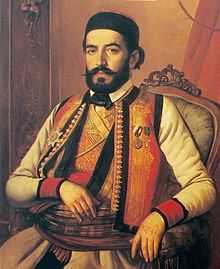

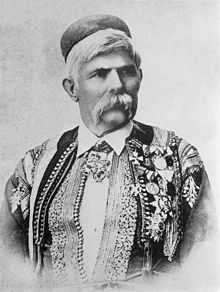



.jpg)




